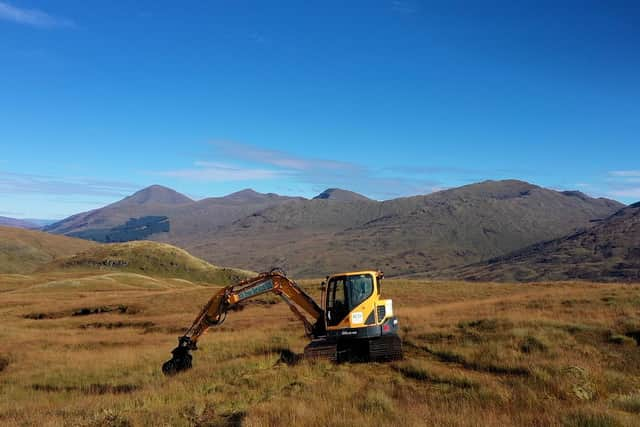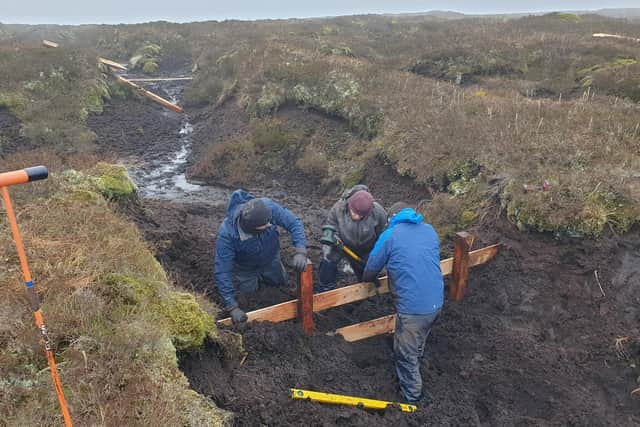Ramping up peatland restoration in Loch Lomond and the Trossachs – Scotland’s original national park
Restoration of the globally important habitat is being extended and accelerated across Loch Lomond and the Trossachs National Park (LL&TNP).
Healthy peat sucks up and stores climate-warming greenhouse gas emissions but when degraded releases them into the atmosphere, contributing to climate change.
Advertisement
Hide AdAdvertisement
Hide AdMore than a third of land in the national park – around 68,000 hectares – is covered by peat bogs, holding an estimated 20 million tonnes of carbon.
Now the park authority has set a target to revitalise 8,000 hectares of damaged peatland by 2030, accelerating the rate of restoration from an average of 240 hectares each year to 640 hectares annually.
This represents a significant increase on the 1,147 hectares which has been brought back to life across the park over the past five years.
“The natural environment could be our greatest ally in tackling the climate emergency with our peatlands and woodlands capable of capturing and storing significant amounts of carbon,” Simon Jones, director of environment at LL&TNP Authority, said.
“Restoring our peatlands to favourable condition is absolutely essential.


“Degraded peatland is an active CO2 emitter and a major source of carbon emissions in Scotland.
“By working with public and private land managers in the National Park, we are scaling up work to restore our peatlands, remove invasive non-native species and reduce herbivore pressures from animals like deer and sheep, ensuring the national park can become a major carbon sink for Scotland.”
Peat bogs, which form over thousands of years, are made up of highly adapted plant species and host a wide range of rare and important wildlife.


Advertisement
Hide AdAdvertisement
Hide AdThey provide a multitude of environmental services, absorbing pollutants, improving water quality and reducing flooding, as well as holding important cultural and economic value for their contribution to farming, tourism, whisky production and fishing.
Scotland hosts a significant proportion of the world’s peatlands, including around 13 per cent of all blanket bog.
Nearly a quarter of the country’s entire landmass is covered in peaty soils, stretching across approximately 1.8 million hectares.
Estimates suggest around 1,600 million tonnes of carbon is stored in peat across Scotland.
The bad news is around 80 per cent are in a degraded condition, caused mainly by human activities such as drainage, conversion for agriculture, burning and forestry planting.
This means they are currently emitting more carbon dioxide than they are absorbing.
After transport, degraded peatland is Scotland’s biggest source of greenhouse gas emissions.
In 2020 the Scottish Government announced a £250 million 10-year funding package for peatland restoration, with a target of restoring 250,000 hectares across the nation by 2030.
Advertisement
Hide AdAdvertisement
Hide AdSome of the fund is administered by the Peatland Action programme, run by government agency NatureScot, with a portion of the cash going directly to national parks.
As part of the Peatland Action programme, LL&TNP Authority is working with local land managers to bring peatlands back to life, improving the condition of uplands traditionally used as grazing for livestock and deer.
Perthshire-based Daniel Carnegie, of DC Restoration Contracts, has been working with the national park to rejuvenate the bogs.
He loves the work and has expanded to employ two new staff and two more diggers.
“There’s massive satisfaction in this type of work,” he said.
“We call it ‘tidying up the hill’, where you start off looking at a hill that’s black with bare bits everywhere and by the time you’ve finished the hags have gone and it’s green.
“And you know you’re doing something important too, helping with climate change.
“It was just me when I started out but there’s three of us now and I might need to start a fourth boy this year.
Advertisement
Hide AdAdvertisement
Hide Ad“Peatland work needs to be ramped up – it needs to happen faster.”
LL&TNP Authority says tackling climate change and biodiversity loss are ‘non-negotiables’ in its Draft National Park Partnership Plan, published last month.
Now input is being invited from everyone with an interest in the region.
“We are already restoring more of our peatlands than ever before and our Draft National Park Partnership Plan sets out our ambitions to do even more, Mr Jones said.
“As part of our ongoing conversation about the future of the national park we want to hear people’s views on how we tackle the climate and nature crises and ensure a sustainable future for the people and places within the park.”
Peatland restoration is a key part of the Scottish Government’s goal of achieving net-zero emissions by 2045 at the latest.
More than 20,000 hectares have already been brought back to health since early 2013.
An ambitious plan to secure Unesco World Heritage Site designation for the peatlands of Scotland’s Flow Country is under way.
Advertisement
Hide AdAdvertisement
Hide AdThe area encompasses a vast area of blanket bog that spreads across 190,000 hectares of Caithness and Sutherland in the far north, with an estimated 400 million tonnes of carbon stored in the ground – more than all the UK’s forests and woodlands combined.
Much of the work involved in revitalising peat is to do with water – rewetting and blocking drainage, adding sphagnum moss, a key part of a bog system, and sometimes removing unsuitable vegetation such as tree plantations.
As well as absorbing emissions, helping control flooding, cleaning water and providing nutrients to the soil, healthy, damp peat is also more resilient against wildfires.
Comments
Want to join the conversation? Please or to comment on this article.